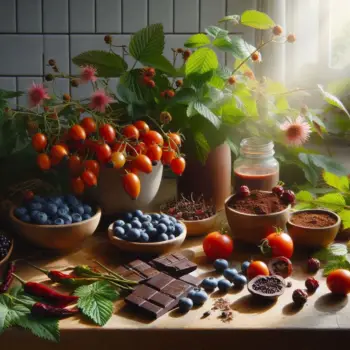Contributing writer for Wake Up World
It’s probably impossible to count all the times you’ve run across an article or study featuring this or that “superfood” found only on some exotic island or in the wilds of China. Information about many superfoods is everywhere, and while they’re interesting and their nutritional profiles may be impressive, aren’t there any superfoods near where you live?
How odd is it that everything that seems to be the best at aiding weight loss, preventing cancer and boosting brain power comes from halfway around the world?
Every state in America has a list of native foods offering impressive vitamins, minerals and other elements essential for health, so wherever you live, there are local foods you may not have thought of to augment your health. Below are five local-for-exotic superfood swaps that not only may surprise you, but will also get your culinary juices flowing.
Super Swap — Lemon Balm for Cacao
Not many would think these two could be interchanged, and maybe the flavors aren’t so similar, but the effects they provide seem to be. If you’re a chocolate lover, you know one of the reasons people crave it — It’s soothing and even somewhat stress relieving. Comparatively, lemon balm — emphasis on “balm” — does what it’s said to do, lifting your spirits but without the stimulation from caffeine.
Native to the eastern Mediterranean and West Asia, Melissa officinalis, like so many other herbs, has been used for centuries as a therapeutic remedy due to its antiviral, antibacterial, antispasmodic and antidepressant compounds. Its modus operandi, according to Natural Living Ideas,1 includes stress relief, relief of pain from indigestion and improving your appetite.
Another use for lemon balm is to promote sleep. You can chop the leaves and steep them in boiling water to make tea or rub a few leaves on your skin to allow the natural oils to seep into your bloodstream, which helps you relax. In fact, a study published in Phytomedicine found that nearly 81% of the participants who used lemon balm with valerian root got a better night’s sleep than those on a placebo.2
And a Northumbria University study reported that experiments with lemon balm returned memory-strengthening and improved problem-solving abilities when they took capsules filled with the dried herb. The subjects also performed “significantly” better when taking standardized computer tests on memory in comparison with those given a placebo.3
One of the great things about lemon balm, a perennial herb and member of the mint family, is how easy it is to grow, particularly in the spring. It can be sown from seed, or you can buy a small plant from a farmers market or nursery, and you’ll be amazed how quickly it grows and spreads.
Acai Berries Can Be Swapped for Blueberries
Acai berries (pronounced ah-sah-EE), a sort of cross between a grape and a blueberry, look very much like the latter and, oddly, taste a little like a berry dipped in chocolate. They’ve been used in traditional medicine to treat infections from parasites, ulcers, hemorrhaging, ulcers and diarrhea.
Acai berries come from the Amazon region. Besides the berries themselves, the juice and pulp are commonly added to teas, fruit drinks, fruit bars and other products geared toward health and vitality.
Nutritionally, these little berries contain high levels of antioxidants, flavonoids and anthocyanins. But as beneficial as acai berries are, their nutritional profile is very comparable to that of blueberries, grown on both U.S. coasts and all over the heartland. The two types of blueberries are differentiated as highbush and lowbush, the latter being the wild variety and higher in anthocyanins. According to the Blueberry Council:
“The first commercial crop of little blue dynamos traveled from farm to table 100 years ago … Native to North America, blueberries have been around for more than 13,000 years — so they have deep roots in our country’s history. Today, we’re still reaping the health benefits of blueberries, and are discovering they have more to offer than our ancestors could have ever imagined.”4
Blueberries have truly remarkable benefits for cardiovascular health, as well as for your brain, insulin response and even cancer prevention. Packed with vitamin C, which boosts your immune system and helps collagen to form, they’re also loaded with fiber for greater regularity, impacting your heart health and manganese, a mineral noted for energy conversion and proper bone development.
Chickweed — The New Wheatgrass
As green as any grass you’ve ever seen, wheatgrass has been a main event in health food circles for decades. People will line up to pay big bucks for a small shot of the stuff, which tastes pretty much like you’d imagine, similar to the aroma of new-mown hay; as one company describes it, “unfamiliar, but not unpleasant.”5
Several of this commodity’s features include fighting aging by revitalizing skin cells, cleansing the blood and fighting tumors. Clinical studies show that it contains 90 minerals, 20 essential amino acids, 13 vitamins and 80 enzymes.
But it’s the 70% ratio of chlorophyll, structurally similar to red blood cells (hemoglobin), that makes it a superfood. World Lifestyle notes that once it’s absorbed, it converts to hemoglobin, mimicking red blood cells and carrying oxygen to vital areas of your body, and may even kill off cancer cells because “cancer cells can’t survive and thrive in oxygen-rich environments.”6
But get this — Chickweed (Stellaria media) is a wild, edible plant (beautiful, too, by the way) growing prolifically in every area of the world other than those that are coldest, like Antarctica. Besides decreasing insect damage to other plants, it’s chockfull of many vitamins, minerals and, like wheatgrass, chlorophyll.
Chickweed stems and flowers can be used raw in salads and sandwiches, tossed into soups and stews or added to cooked dishes (but at the end as the stems and leaves are delicate).
Frontier foragers learned that when they gathered chickweed, almost exclusively in the spring, it was useful as both food and medicine. As a food, Foraged Foodie7 observes, the raw form is covered with a fine layer of fibers, which are minimized when they’re gently chopped and sautéed or wilted.
Rose Hips Can Take the Place of Goji Berries
Goji berries are renowned for having a lot of vitamin C. Originally from Asia, they were used by the ancients to replenish body fluids, improve skin and soothe jangled nerves. The bush-like plant belongs to the nightshade family of plants with tomatoes and peppers and is reputed to be beneficial for insomnia, tuberculosis and to increase testosterone.
On the other hand, rose hips, the fruits or seed pods of the wild roses you see growing everywhere throughout the U.S in late summer or fall, contain so much vitamin C, aka ascorbic acid, they’re actually known to be the most abundant source in the world, which explains why they’re so sought after by many markets.
It was only in the last several decades that anyone thought to consider if there might be actual nutrition in rose hips. Once used in animal food, today they’re an ingredient in jams, jellies and pie, as well as soups, bread and wine. Bon Appetit adds:
“The hips, like the petals, are high in flavonoids, those small but mighty antioxidant friends. Like nettle, rose hips are anti-inflammatory. The pectin in rose hips also make it a heart healthy medicine …”8
Treehugger9 adds vitamins A and E to rose hips’ benefits, so they can be made into tea or even eaten to help treat colds and sore throat. Because they also contain free radical-fighting antioxidants, the anti-inflammatory properties can even treat rheumatoid arthritis.10
The odd pods also contain pectin, which is good for your heart. Organic Facts11 reveals more advantages of consuming rose hips in some form, including an ability to optimize cholesterol, boost your immune system, prevent chronic disease such as cancer, regulate your blood sugar and eliminate toxins.
Nettles Compared to ‘Superfood’ Spirulina
Although spirulina technically does grow in ‘the States,’ it’s only one — Hawaii, as well as other exotic areas of the world, so it’s understandable that many think of it as not exactly around the corner. But first of all, what is it? If you’ve heard of blue-green algae, you’re halfway there.
Spirulina’s deep blue-green color reveals its active ingredient — chlorophyll — clearly. Health.com12 explains it as one of the oldest life forms on Earth and possibly consumed in Aztec and African diets centuries ago.
Today it’s touted for its ability to strengthen the immune system, reduce fatigue and combat allergies. Nettles are another plant with chlorophyll that even rivals the amount found in spirulina, but they’re often found in ditch banks, forests and riverbanks.
It’s sometimes called “stinging nettle” because it does just that; if you touch it without wearing gloves, the tiny hairs on every surface sting like a bee due to the presence of formic acid, leaving small red welts. But internally, Bon Appetit asserts, it acts like a tonic:
“Taken over time, nettle will strengthen your circulatory, immune, and endocrine systems to promote peak function. The stronger these systems, the better position our bodies are in to deal with whatever might come our way.”13
Cooked or dried, though, this pesky stinging problem goes away completely; good thing, too, because this free foraging food is highly nutritious, containing fiber, lecithin, chlorophyll, sodium, iron, phosphorus, sulfur, potassium and vitamins A and C, according to Mother Earth News. It’s been used in birth rooms and battlefields to stop bleeding, both internally and externally, and is considered to purify blood, as well. As a tea:
“It has been found to help cure mucus congestion, skin irritations, water retention and diarrhea … stimulate the digestive glands of the stomach, intestines, liver, pancreas and gall bladder. Applied externally, nettle tea … relieves rheumatism in both people and animals, makes a first-class gargle for mouth and throat infections, helps to clear up acne and eczema and promotes the healing of burns.”14
The top two or three pairs of leaves are the most tender. Again, use gloves then tongs to transfer the saw-toothed leaves from your gathering bag to the sink for rinsing, and to the pan for sautéing, say, with onions and garlic in butter or ghee, sea salt and Parmesan cheese.
What About Common, Local, Easy-to-Grow Superfoods?
Among all the vegetables grown in the U.S. (although elsewhere, as well) broccoli is arguably one of the most nutritious. You don’t have to look far for the reason — sulforaphane, an organic sulfur found in broccoli and other cruciferous vegetables. Not only does it support normal cell function and division, it also helps your body detoxify and reduces inflammation and damage from reactive oxygen species (ROS).
Broccoli sprouts — the nutrient-dense superfood starter from broccoli seeds — are linked to the prevention of many serious diseases, from heart disease to diabetes. They, too, can help detoxify even such environmental pollutants as benzene and protect against cancer.
Besides sulforaphane, this is also due to powerful compounds such as the glucosinolate glucoraphanin, which helps improve blood pressure and kidney function, and isothiocyanate, known to normalize DNA methylation.
Arugula is another powerhouse veggie, often known as “rocket” due to its spicy flavor. As a green, it’s very versatile. As another Brassicaceae along with cabbage and broccoli, it has many of the same nutrients and healing compounds, including fiber, vitamins A, C (to boost the immune system) and K (for bone strength), folate, calcium, potassium, iron, magnesium, phosphorus and manganese.
One study shows arugula to be a powerful aid against gastrointestinal ulcers, psoriasis and skin, lung and mouth cancers. Many more vitamins and minerals help lower blood pressure and improve blood vessel function. The amazing thing is this fancy-looking green is very easy to grow and, like many others, can be mixed with other greens with supportive nutritive value.
Sources and References
- 1 Natural Living Ideas March 8, 2017
- 2 Phytomedicine, Volume 13, Issue 6, 12 June 2006, Pages 383-387
- 3 Northumbria University April 29, 2016
- 4 Blueberry Council
- 5 Dynamic Greens 2017
- 6 World Lifestyle, What’s Up With Wheatgrass? (Archived)
- 7 Foraged Foodie March 3, 2016
- 8, 13 Bon Appetit July 19, 2017 (Archived)
- 9 Treehugger, November 23, 2019
- 10 Curr Mol Pharmacol. 2021;14(5):731-745
- 11 Organic Facts 2024
- 12 Health December 27, 2016 (Archived)
- 14 Mother Earth News March/April 1981
About the author:
Born and raised in the inner city of Chicago, IL, Dr. Joseph Mercola is an osteopathic physician trained in traditional and natural medicine. Board-certified in family medicine, Dr. Mercola served as the chairman of the family medicine department at St. Alexius Medical Center for five years and, in 2012, was granted fellowship status by the American College of Nutrition (ACN).
While in practice in the late 80s, Dr. Mercola realized the drugs he was prescribing to chronically ill patients were not working. By the early 90s, he began exploring the world of natural medicine and soon changed the way he practiced medicine.
In 1997, Dr. Mercola founded Mercola.com, which is now routinely among the top 10 health sites on the Internet. His passion is transforming the traditional medical paradigm in the United States. “The existing medical establishment is responsible for killing and permanently injuring millions of Americans… You want practical health solutions without the hype, and that’s what I offer.”
Visit Mercola.com for more information, or read Dr. Mercola’s full bio and resumé here.
What if slowing down could improve your energy, health, and relationships? In this free online event, you’ll learn how The Slow Method — rooted in Qigong, Taoist philosophy, and breathwork — helps reduce stress, boost vitality, and create a sense of peace in your daily life.
Through guided Qigong practices, you’ll discover how to activate your body’s natural healing abilities, improve emotional balance, and even slow the aging process. Slowing down doesn’t mean falling behind — it’s a powerful way to regain clarity, connection, and energy.
Join this transformative workshop and experience how simple practices can change your life. Sign up for free now and discover the counterintuitive path to healing and vitality.
 If you’ve found value in our articles, we’d greatly appreciate your support by purchasing Mindful Meditation Techniques for Kids—A Practical Guide for Adults to Empower Kids with the Gift of Inner Peace and Resilience for Life.
If you’ve found value in our articles, we’d greatly appreciate your support by purchasing Mindful Meditation Techniques for Kids—A Practical Guide for Adults to Empower Kids with the Gift of Inner Peace and Resilience for Life.
In the spirit of mindfulness, we encourage you to choose the paperback version. Delve into its pages away from screen glare and notifications, allowing yourself to fully immerse in the transformative practices within. The physical book enriches the learning process and serves as a tangible commitment to mindfulness, easily shared among family and friends.
Over the past few years, Wake Up World has faced significant online censorship, impacting our financial ability to stay online. Instead of soliciting donations, we’re exploring win-win solutions with our readers to remain financially viable. Moving into book publishing, we hope to secure ongoing funds to continue our mission. With over 8,500 articles published in the past 13 years, we are committed to keeping our content free and accessible to everyone without resorting to a paywall.









